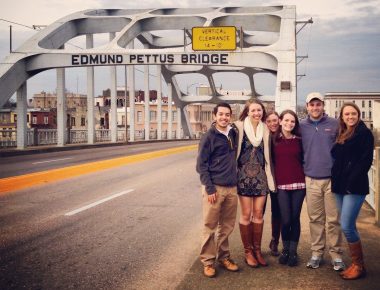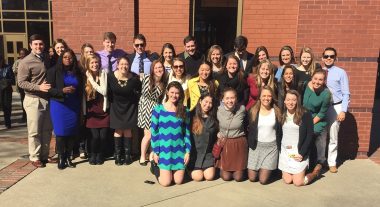Twenty-eight Elon sophomores toured the South this winter as part of a course on nonviolence and the civil rights movement.

The class toured historical locations in the Deep South, visiting Birmingham, Selma and Montgomery, Alabama, before concluding its trip in Atlanta. Frances Ward-Johnson, associate professor of communications, and Jodean Schmiederer, associate dean of students for leadership, accompanied the student contingent.
Before departing, the Fellows spent two weeks engaging in discussions and reading books, including “Cradle of Freedom: Alabama and the Movement that Changed America” by Frye Gaillard; “The Informant: The FBI, the Ku Klux Klan, and the Murder of Viola Liuzzo” by Gary May; and “Eating Dr. King’s Dinner” by Chuck Fager.
In addition, students traveled to the International Civil Rights Center & Museum in Greensboro, North Carolina, and they gathered as a class at a local theater to view the movie “Selma.” While the class teachings and afternoon excursions were memorable, students explained their journey through the Deep South left the most indelible impression.
“I enjoyed my Winter Term trip to the South because I was able to learn more in detail about the civil rights movement,” said Steven Armendariz ’17, a political science major from Charlotte. “The people are very friendly, and they recognize what happened in the past was wrong, but look at it as a stepping stone toward equality.”
The trip began in Birmingham where the class visited the Civil Rights Institute, Kelly Ingram Park and the 16th Street Baptist Church. The institute taught students how the city of Birmingham received its nickname, “Bombingham,” a reference to the 50 unsolved bombings during the movement. Kelly Ingram Park is the infamous location where Birmingham Public Safety Commissioner Bull Connor instructed police officials to use powerful water hoses and fierce dogs to combat nonviolent civil rights activists in 1963.

The 16th Street Baptist Church commemorates four girls who were killed by a bomb planted by a member of the Ku Klux Klan.
In Selma, the group toured the National Voting Rights Museum & Institute and the Slavery and Civil War Museum, walked across the Edmund Pettus Bridge, and visited the memorial of Viola Liuzzo, a woman from Detroit who was among those killed during the movement. The museums explored the American slave trade in the early 1600s and detailed how blacks earned the right to vote in 1965.
It was on the Edmund Pettus Bridge where students could connect their current thoughts and feelings with those who had marched for their voting freedom on Bloody Sunday. On March 7, 1965, 600 unarmed marchers were attacked on the site.
“It was really powerful to stand on the bridge where Bloody Sunday happened and where the March to Montgomery began,” said political science major Alex Vandermaas-Peeler ’17 from Saxapahaw, North Carolina. “I thought about how scared (Andrew) Young and (John) Lewis must have been to lead the march. I looked at the ground and wondered if I stood at where Amelia Boynton had laid unconscious. The bridge’s history is mixed; while Bloody Sunday was horrifying, the march to Montgomery was a victory as was the [Voting] Rights Act which came from the movement in Selma.”
After Selma, the group ventured to Montgomery to learn more about Martin Luther King Jr.’s home at the Dexter Avenue Baptist Church Parsonage, Rosa Parks and the bus boycott, the Civil Rights Memorial and Southern Poverty Law Center, and the Montgomery state capitol.

“I thoroughly enjoyed my time at Ebenezer Baptist Church,” said finance major Dex Blank from Elon. “The people were more than welcoming, the sermon was uplifting, and I didn’t want the worship to ever end. It was definitely an experience I’ll never forget.”
According to Ward-Johnson, the class and the trip help Leadership Fellows gain a sense of knowledge about how nonviolence and leadership intertwined in the civil rights movement.
“Before this trip if you asked me who was involved with this movement, I would only be able to name MLK and Rosa Parks off the top of my head,” said Britt Chertock ’17, an entrepreneurship and management double major from West Palm Beach, Florida. “Now, I realize the depth of this movement. It’s important that we remember how far we’ve come and how far we still have to go.”
Story submitted by Ashley Bohle ’17


